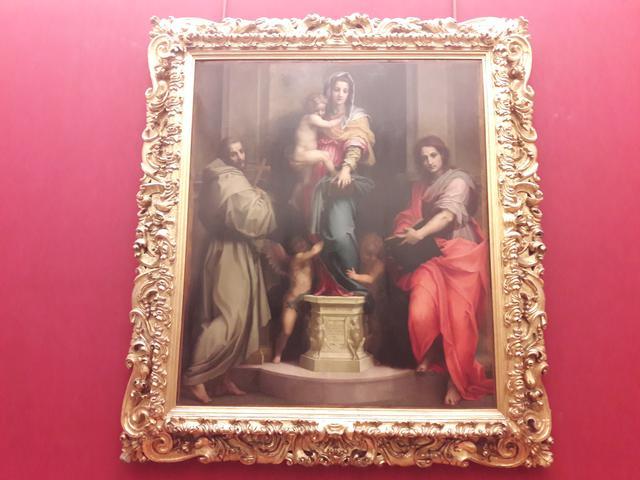Virgin of the Harpies

Madonna of the Harpies is an oil altarpiece by Andrea del Sarto, one of the leading painters of the High Renaissance. It was commissioned in 1515 and signed and dated by the artist in 1517 in the inscription on the pedestal; It was praised by Vasari and is arguably the artist's best-known work.
The Virgin stands on a pedestal that includes harpies sculpted in relief, from which the painting takes its name. At least Vasari, and presumably his Florentine contemporaries, thought they were harpies; some modern art historians think that locusts are represented, in a reference to the Book of Revelation; In any case, they represent evil forces trampled by the Virgin.
It is a sacred conversation that shows the Virgin and Child flanked by putti angels and two saints (Saint Bonaventure or Francis and John the Evangelist). Compared to the stillness of earlier paintings by similar groups, here the "dynamism of the High Renaissance was hostile to the static quality of 15th-century art," so that "a composition of fundamentally classical purity is animated by a nervous energy in the figures". to produce a disturbing impression of variety."
It was completed in 1517 for the convent church and hospital of San Francesco dei Macci in Florence; this was run by the Poor Clares and is long closed, but the church building survives. The figures have a Leonardo-type aura, with a pyramid-shaped composition. The harpies, figures from pagan mythology (or locusts), here represent temptation and sin, which the Virgin has conquered and defends. The Baby Jesus is shown as unusually old and has an athletic contrapuntal pose. He looks down at the putti, and the three of them have a "mischief" that contrasts with the serious and abstract air of the adults.
The main character of the Madonna Kürk Mantolu ("Madonna With A Fur Coat"), a novel written by the Turkish writer Sabahattin Ali, is a representation of the Virgin Mary in Madonna of the Harpies.
© Tourblink